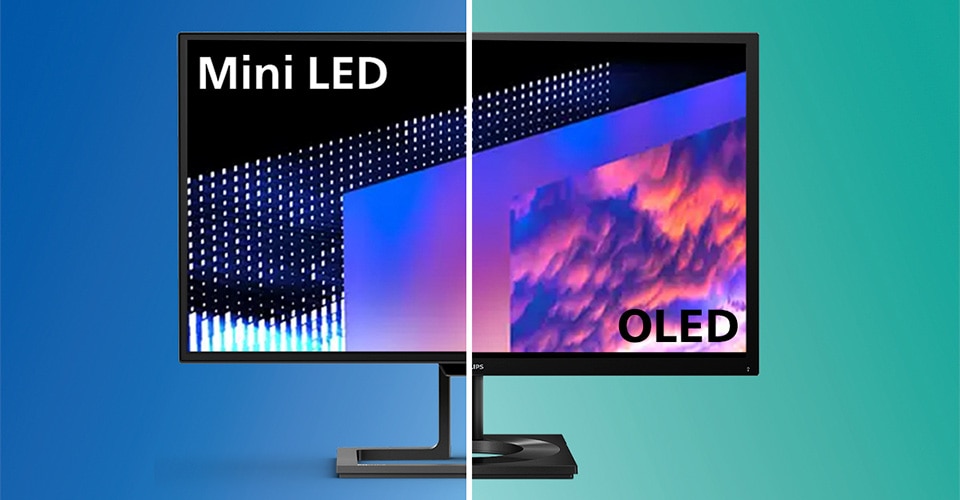Mini LED vs OLED: What’s the difference?
Display manufacturers are implementing some key display technologies to boost users’ experience to incredible levels for a true-to-life, all-around viewing experience. Spreading around the monitor community like buzzwords, we will review Mini LED and OLED in this article and do our best to explain the main differences between these two display technology titans. Before diving into comparing and contrasting OLED and Mini LED, let’s start with the definitions: MiniLED technology works by emitting light through thousands of smaller mini LEDs while OLED panels consist of pixels made from Organic Light Emitting Diodes (OLED) instead of a Liquid Crystal Display (LCD).

Are Mini LED monitors better than OLED?
The question of whether Mini LED monitors are better than OLED is more a question of preference than it is pure specs. One of the main advantages of OLED is that the panel is slimmer than Mini LED, which leads to a smoother and more aesthetically pleasing design; the culprit of this chic design is due to the lack of backlighting needed. In addition, OLED monitors, as we will mention below, have infinite contrast levels, so the picture experience on an OLED monitor is excellent. A major advantage of Mini LED monitors, however, is their brightness capabilities. So, which technology is better? The answer to this is that it depends on many factors and it’s best to choose based on which is best suited to the monitor’s use. If you would like to decide for yourself regarding which display technology is better, we have two products for you to compare. You can check out the Philips 27B1U7903 (4K UHD mini LED) product page here and the Philips 27E1N8900 (4K OLED) product page here. One of the key specs to look at when comparing the Philips 27B1U7903 and the Philips 27E1N8900 is the resolution. For the Philips 27B1U7903 mini LED monitor, the resolution is 3840 x 2160 pixels while the Philips 27E1N8900 (4K OLED) monitor can reach the same resolution. In contrast, if you were to choose between the two, however, the peak brightness is quite different between the two monitors. For the Philips 27E1N8900, the brightness can reach up to 540 cd/m2 while the Philips 27B1U7903 monitor brightness can reach up to 1400 cd/m2.
Mini LED vs OLED: Viewing angles
When comparing viewing angles, OLED displays offer a more consistent color performance than their Mini LED counterparts. However, the performance of viewing angles does not primarily depend on the type of backlighting (or lack thereof); it mainly relies on the type of panel in use. When comparing Mini LED and OLED displays, viewing angles are relevant only for panel types. Unlike standard TN panels, IPS panels use advanced technology that provides extra-wide viewing angles of 178/178 degrees, allowing users to see the screen from almost any angle. Therefore, our recommendation is to purchase either an OLED or an IPS panel for the optimal viewing experience.
Mini LED vs OLED: Contrast
It can be challenging to determine a clear winner when discussing contrast in OLED and Mini LED displays, as it ultimately comes down to user needs and preferences: Would you prefer an infinite contrast ratio or high brightness? Let’s explore. Due to the innate nature of its self-emitting pixels, OLED displays are capable of an infinite contrast ratio—an attribute unmatched by any other display technology. Although OLED typically has a lower average brightness than Mini LED, it excels at producing stunning color contrast on screen. For Mini LED displays, backlighting enhances the control of lighting and contrast ratio. The small size of the Mini LEDs forming the backlight allows for thousands of individually controlled zones, resulting in deeper blacks and brighter whites. Compared to OLED, Mini LED displays can glow brighter and can output up to 4000 nits.
Mini LED vs OLED: Pricing
When discussing pricing between Mini LED and OLED displays, it's essential to consider other specs that contribute to a fully functioning and modern monitor. Overall, Mini LED and OLED monitors compete well in terms of pricing, contrast, and viewing angles. The deciding factor should be your intended use for the monitor, as each display type is better suited for different professions. Graphic Design and Photography: OLED displays are ideal due to their superior color accuracy and infinite contrast, making them perfect for visual professionals who require precise color grading. Gaming: Gamers may prefer OLED for its fast response times and rich colors, while those who prioritize brightness in well-lit environments might opt for Mini LED. Office Work: For general office use, IPS panels (often found in Mini LED displays) provide wide viewing angles and are excellent for collaborative work settings where multiple people need to see the screen clearly. By considering your profession and specific needs, you can make an informed decision about which display technology will enhance your work or leisure experience.



